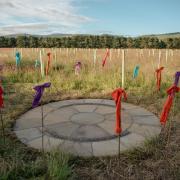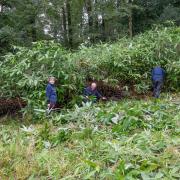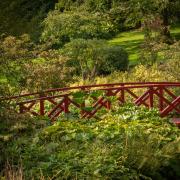It is well documented that regular connection with nature improves mental and physical wellbeing along with fostering a deeper appreciation for wildlife, habitats and the natural world.
Sadly, we are seeing an increased lack of child exposure to outdoor experiences resulting in higher cases of nature deficit disorder in our children and young people.
Schools and other therapeutic settings are looking to readdress their provision of nature-based activities with Forest School and Outdoor Learning opportunities being prioritised with a movement towards delivery of Forest School programmes embedded holistically within the school’s curriculum as well as seeing a huge increase in community led programmes.

Forest School was originally developed as a child-led learning experience however, we have seen the benefits of how a Forest School approach can support the mental wellbeing and development of children, teenagers and adults by improving confidence and self-esteem through learner-inspired experiences in the woodland environment. Providing opportunities for participants the freedom to explore their surroundings in the woodland contributes to an understanding of wild animals and their habitats along with a greater respect and appreciation for nature, threats to biodiversity and the importance of conservation.
The Wildlife and Conservation Management team at the Barony campus are pleased to announce we have been approved to deliver SCQF Forest and Outdoor Learning Awards (FOLA) which will provide a valuable opportunity for existing students and external candidates to train to become Forest School and Outdoor Learning Practitioners.

Scotland’s peatlands are globally important and are world famous for their beauty and stunning wildlife. Peatlands make up more than a third of our landscape. But sadly, almost 80% of these precious ecosystems are degraded.
Eroding peat smothers salmon eggs, damages delicate fish gills and kills the aquatic insects fish eat. Drainage channels cut into peat can trap baby grouse which are then killed by heavy rain. Water or “peat tea” flowing from damaged peatlands is stained and full of sediments. So, by repairing peatland we reduce treatment costs and therefore our water bills.
Damaged peatlands also look ugly, and they emit about 15% of Scotland’s total carbon dioxide emissions, which is about the same as that released by our entire transport system.
We can fix our peat bogs so that wildlife gains, water quality improves, flood risks diminish, and landscapes look better, and all this without lifestyle changes needed by the public. Peatland restoration is the single most useful thing Scots can do to help heal our damaged land and address the twin emergencies of Climate Change and Biodiversity Loss. Degraded peat bogs leak huge amounts of carbon. Healthy bogs not only absorb CO2, but crucially, they hold onto it for thousands of years.
The Scottish Government, through NatureScot’s Peatland Action programme, has allocated £250 million to restore 250 000 hectares by 2030. In the last ten years we’ve managed about 10% of that. To restore the rest, we’ll need many more people who have the relevant skills. The target is huge, the skilled and experienced workforce small. SRUC at Barony is leading training programmes aiming to boost the numbers of people who can restore peatland ecosystems. Our world-leading courses are addressing this need by teaching how to assess the condition of peatlands and how to select and evaluate the most appropriate restoration techniques.
By providing training in all the aspects of the design process, we enable people to access Peatland Action funding and develop effective projects. Together we can build a workforce that can take Scotland on a journey towards Net Zero and a richer biodiversity.

It’s common knowledge that trees are vital to our survival, and with the planet changing rapidly due to climate change and the biodiversity crisis, the disciplines of forestry, arboriculture and urban forestry have equally vital roles to play in our future.
Forests (including urban forests) regulate our ecosystems. They protect and enhance biodiversity and capture and store large amounts of carbon dioxide, the gas which – when emitted to excess – is responsible for our warming planet.
The urban forest will play a crucial role in our future cities, contributing both to the circular economy and climate mitigation, with trees estimated to meet 15 of the 17 internationally supported United Nations Sustainable Development Goals.
In Scotland, woodland and forests (including urban forests) cover nearly a fifth of our total land mass, the highest level in the UK, although still well short of the European average of 38 per cent. However, this figure is going to increase markedly over the next few years, through reforestation and rewilding programmes.
Timber is among the most valuable construction materials, we must reduce the current imported level of 80 per cent to meet the increased demand and avoid the exploitation of forests worldwide.
Dumfries and Galloway produces around 30% of Scotland’s annual timber harvest and the timber industry is a major employer within the region with around 3000 jobs across all sectors. However, continued growth of the industry and increased mechanisation has led to a recognised skills gap and further employment opportunities across all related sectors.
The forestry and arboriculture programme delivered from the Barony Campus at Scotland’s Rural College (SRUC) will help to address these climatic concerns and
will also help address the skills gap through training the foresters and arborists of the future with courses ranging from pre-apprentice in work readiness through to the Higher National Diploma in Forestry.
The forestry team is currently expanding its full-time courses, with the first higher education programme in arboriculture and urban forestry due next year.
We also provide short course training to professionals in industry and young graduates, such as the recent collaborative graduate scheme between Tilhill’s education arm, the Foresight Sustainable Forestry: Skills Training Programme and the SRUC Skills Academy.
Alongside practical courses, we are developing higher education short courses, including wood decay and hazard assessment of trees, tree canopy access training, and the use of drones in forestry for beginners.
SRUC is in the enviable position to meet forestry challenges of the future through flexibility and a diverse skills set – key requirements in a rapidly changing world.
Dr Hugh Morris, Programme Leader and Senior Lecturer for Forestry and Arboriculture, SRUC
"To find out more about any of the courses offered at SRUC visit www.sruc.ac.uk/barony or email study@sruc.ac.uk"



























